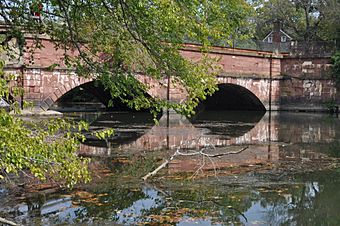Seneca Aqueduct facts for kids
Quick facts for kids |
|
|
Seneca Aqueduct
|
|
|
U.S. Historic district
Contributing property |
|

Aqueduct, with Riley's Lockhouse at upper right.
|
|
| Nearest city | Poolesville, Maryland |
|---|---|
| Part of | Seneca Historic District (Poolesville, Maryland) (ID78001475) |
| Added to NRHP | November 15, 1978 |
The Seneca Aqueduct is a special kind of bridge that carries the Chesapeake and Ohio Canal (C&O) over Seneca Creek in Montgomery County, Maryland. It is also known as Aqueduct No. 1. The C&O Canal had eleven such bridges along its 184.5-mile (297 km) path.
The Seneca Aqueduct is very unique. It was the first aqueduct built for the C&O Canal. It is also the only one made from red sandstone. Plus, it's the only aqueduct that also works as a lock. This lock is called Lock 24, or Riley's Lock. You can find it at the end of Riley's Lock Road in Seneca, Maryland.
Contents
Building the Aqueduct
The Seneca Aqueduct was built between 1829 and 1832. It has three arches made of red sandstone. This stone came from the Seneca Quarry, which was very close by.
The first part of the C&O Canal opened in 1830. It reached as far as Seneca Creek. The next part of the canal opened in 1833. This section went from Seneca to Harpers Ferry.
What Was Nearby?
Near the aqueduct, there was a large area called a "turning basin." This was a wide spot in the canal where boats could anchor or turn around. Right next to the aqueduct and lock, there is also a lock keeper's house. This house was also built using the same red sandstone from the Seneca Quarry.
Because of the canal, the quarry, and other mills on Seneca Creek, the town of Seneca was a busy place. Many people lived and worked there.
Life on the Canal
Life on the canal was usually calm, but sometimes accidents happened. In 1897, a steam boat named Anna Wilson was leaving the aqueduct. It crashed into a freight boat that was full of watermelons. The Anna Wilson sank, but luckily, no one was hurt. People living nearby had fun fishing the floating watermelons out of the basin!
The C&O Canal was used for 96 years. It finally closed down in 1924.
Aqueduct Today
A big flood in September 1971 caused damage to the aqueduct. The westernmost (farthest west) of its three arches was destroyed. The National Park Service has since added strong steel beams to support the aqueduct.
Today, the Seneca Aqueduct is part of the Chesapeake and Ohio Canal National Historical Park. The National Park Service takes care of it. The aqueduct is also part of the Seneca Historic District in Montgomery County, Maryland.
Images for kids
More Information
- Sheir, Rebecca (2012-03-30). "From Stone to Bright Red Structure: A Tour of the Seneca Quarry." WAMU FM Radio (Washington, D.C.)
- Seneca Quarry, Montgomery County, Inventory No.: M: 17-52, including photo in 1997, at Maryland Historical Trust website





